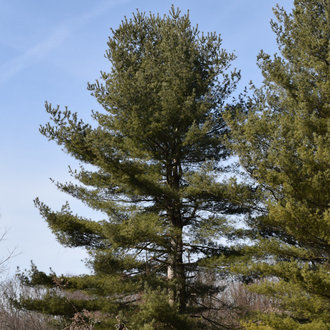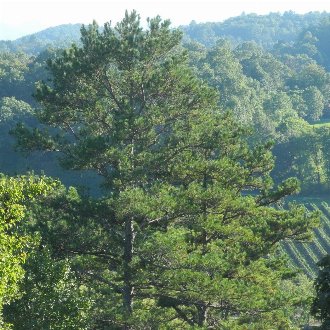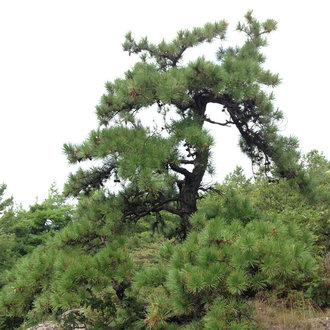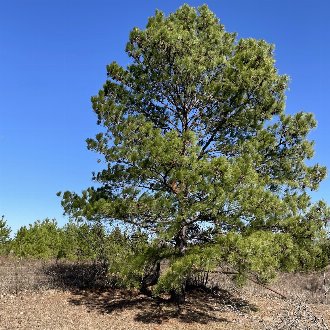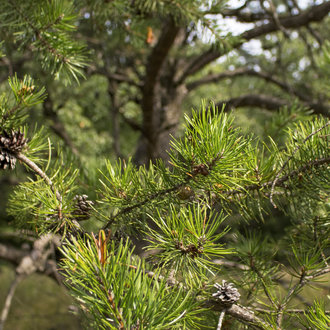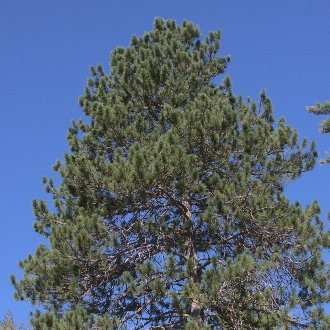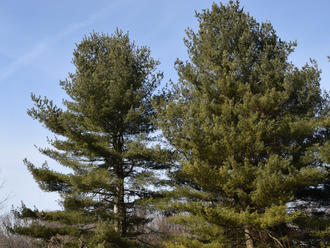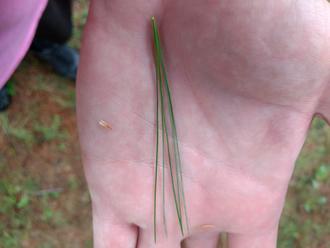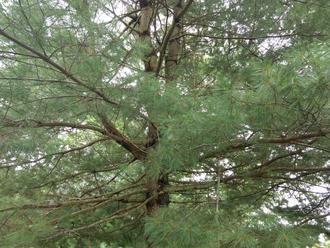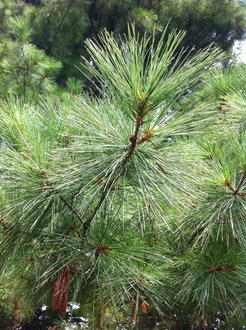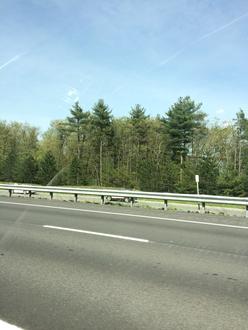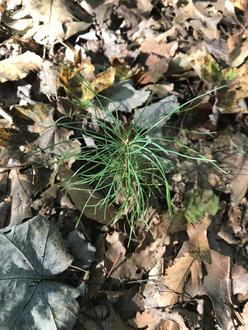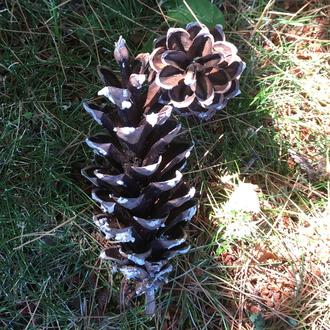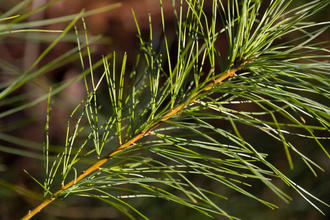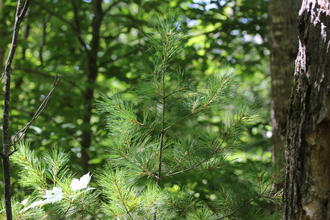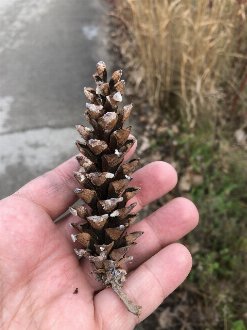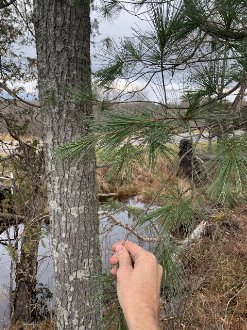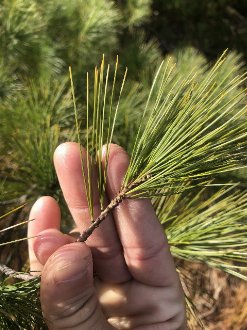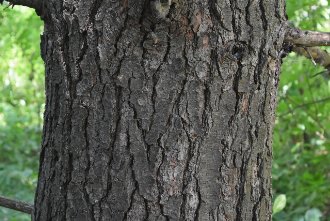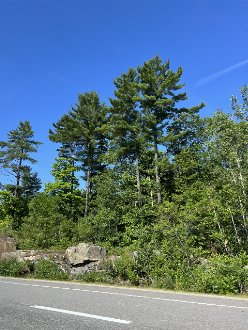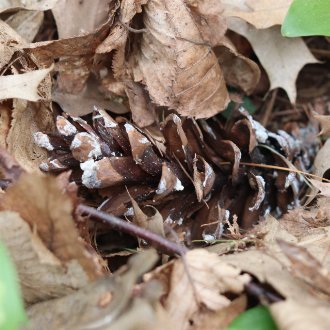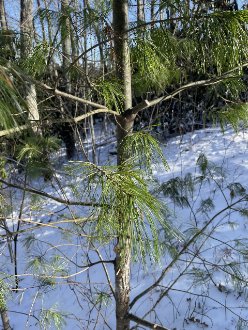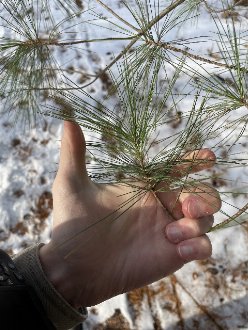Eastern White Pine (Pinus strobus L.)
Also known as Weymouth pine.
↑Summary
A common native pine of the northeast, Eastern White Pine is the tallest tree in the east, and more shade-tolerant than most pines.
↑Range - Expand
| Legend | Color |
| Native | |
| Native or Expanded | |
| Native or Not Present | |
| Native or Expanded or Not Present | |
| Expanded |
This map is based on our research. We have checked its accuracy to Level 3 ecoregions. Although this plant occurs somewhere in each of these regions, it may only occur in a small part of some or all of them.
This species is widely planted in landscaping, and also sometimes in plantations for timber; as a result, new populations have formed south and west of its native range. We mark these as expanded because they are mostly adjacent to its native range and follow the pattern of becoming more spotty as one moves farther south and west. These populations, however, are not terribly vigorous and this species may die out in these areas as the climate warms.
↑Description & Identification
A large evergreen tree, often towering over other vegetation, even canopy trees in a mature forest. Old growth trees commonly reached 150ft in height, with trees recorded over 200ft; nowadays heights of 80-150ft are more common, with record trees just over 180ft. Needles are in bundles of 5. The needles are narrower than most pines, leading the foliage to have a fine texture from a distance. Needles are soft and flexible, and are bluish-green above and whitish below, leading the foliage to have a pale, slightly bluish appearance from a distance.
Trunk buttressed at base, In dense forests, trees usually lack lower branches, as they self-prune readily. Trees on open sites and forest borders may retain lower branches.
The root system is widely spreading and also deep, but lacking a distinct taproot.
↑Similar Plants
↑Habitat
Found on a range of sites from wet to dry, and nearly all soil types, although it is more likely to dominate on sandy or other well-drained, nutrient-poor soils. Limited to more humid climates and more dominant in microclimates with abundant atmospheric moisture. A dominant tree in northern pine forests on drier sites. Found as a scattered tree often towering over other hardwoods, in mixed coniferous-hardwood forests. Uncommon in the south and west of its range, where it is often restricted to cooler north-facing slopes. Often found on the east shores of lakes.
In New England, common on old fields and recently abandoned agricultural lands.
Found in all successional stages of forests.
Presence on any sites is dependent on site history, reflecting presence of a seed source during key stages of disturbance that would allow its establishment.
Although suitable habitat for this species is common and widespread, human intervention has decreased the prevalence of this species.
↑Life Cycle
Seedlings grow slowly initially, and are more shade-tolerant than most pines, growing best when surrounded by some herbaceous vegetation or partly shaded by other trees. Seedlings require at least 20% direct sunlight, and experience maximum growth at about 45% of full sunlight. Seedlings grow best on sites where dew condenses on needles.
Begins producing seed at 5-10 years of age, but seed production is sparse until 20-30 years of age. Some seed is produced every year, but production peaks irregularly at 3-5 year intervals.
Seeds are primarily wind-dispersed, but are also distributed by seed caching by animals, including mice, voles, and squirrels.
On sunny sites, seeds germinate in moist mineral soil, in beds of mosses, and areas with light to moderate density of short grasses. In shade, seeds are also able to germinate in dry mineral soil, pine litter, lichen, or under very thin or very thick grass cover. Most seeds germinate or die after the first year, but a small number of seeds are able to germinate in the second year. None survive to the third year and there is no seed-banking.
Commonly reaches 200 years of age, and can live over 450 years. Commonly reaches 120-130 feet in height, and has been recorded reaching 150-180 feet. Old trees often tower above other vegetation.
This species does not reproduce vegetatively and does not resprout following top-kill. Plants 60 feet tall or higher are able to survive low-intensity fires, but young trees are highly vulnerable to fire. Needle litter is less flammable than many pines. Even mature trees are vulnerable to severe ground fire, which damages the root system, as well as crown fires. This species self-pruning habit reduces the risk of surface fires spreading into the crown.
↑Faunal Associations
The seeds are eaten both by birds and small mammals. The foliage of young plants is sometimes browsed by rabbit and deer, and gophers graze on the roots. Bear cubs often climb these trees to escape danger.
Eastern white pine are one of the most important trees for bird nesting sites. Bald eagles often prefer these trees as they tower above other vegetation. Common grackles also frequently use stands of this species for nesting, forming large colonies that can span across many trees. Cavity-nesting birds, including larger birds such as woodpeckers and smaller such as chickadees, use older, decaying trees, especially those with broken tops, as nesting sites. Mourning doves and pine warblers also nest in this species, and pine warblers spend most of their time in this and other pines.
White pine also supports numerous insects, mostly ones that eat other pines, including many moth caterpillars, and the larvae of various sawflies, beetles, midges, and other insects. The weevil Pissodes strobi prefers this species over other pines, and is one of the most damaging insects.
↑Uses
This species is widely planted as a landscaping plant. In many regions it is the dominant pine used in landscaping. It is preferred for its ease of growing, although it is intolerant of compacted clay soils, alkaline soils, and heavy air pollution, and it is less suitable to warmer climates south of its native range. Its self-pruning, causing it to drop large, heavy branches, and massive size makes it a poor choice for planting close to buildings.
Eastern white pine has also been used to reclaim land damaged by strip mining, especially of coal in the Appalachians. It can tolerate pH down to 4.0, and is able to establish even on sites with dense herbaceous vegetation, but is sensitive to soil compaction and surface salts.
Also widely planted in open, rural areas as a windbreak. As older trees often lose lower branches, in the long-run it is best paired with more shade-tolerant species such as spruce or fir (in colder climates) or American holly (in the south of its range) which can cover the lower portion of the windbreak as it ages.
The wood is commercially important; it is one of the most widely used species for construction in the northeast. Like other white pines, it has a lighter color than yellow pines, has a finer and less-pronounced grain, and is slightly softer and weaker. Its texture is finest among white pines, but it is otherwise similar to the wood of western white pine (Pinus monticola) and sugar pine (Pinus lambertiana). It is easy to work, but not very decay-resistant. Historically, it was also used for ship masts, where it was valued for its long, straight trunks.
↑Related Plants
In North America this species is most closely related to other white pines, with 5 needles per bundle. Possibly the closest relative is Pinus chiapensis, only native to southern Mexico, followed by limber pine (Pinus flexilis), native to western North America, and Pinus ayacahuite, also native to southern Mexico.
Also in the white pine group but probably slightly less closely related is western white pine (Pinus monticola), as well as numerous other species, including many native to East Asia.
All of these closely related species have entirely non-overlapping ranges with this species. The other pines that co-occur in this species range are less closely related and do not hybridize with this species.
↑Links & External Resources
• Eastern White Pine | The Wood Database (About This Site)
• Eastern White Pine | Fire Effects Information System (FEIS) (About This Site)
• Pinus strobus (White Pine) | Illinois Wildflowers (About This Site)
• Pinus strobus (Eastern White Pine) | USDA PLANTS Database (About This Site)
• Pinus strobus | Go Botany (About This Site)
• Pinus strobus (Eastern White Pine) | Missouri Botanical Garden Plant Finder (About This Site)
• Eastern White Pine | Virginia Tech Dendrology Factsheets (About This Site)
• Eastern White Pine | Silvics of North America (About This Site)
• Pinus strobus | Biota of North America Project (BONAP) (About This Site)
• Pinus strobus | NatureServe Explorer (About This Site)
• Pinus strobus | Flora of North America (About This Site)
• Eastern White Pine | Maryland Biodiversity Project (About This Site)
• Pinus strobus L. (Eastern White Pine) | Digital Atlas of the Virginia Flora (About This Site)



